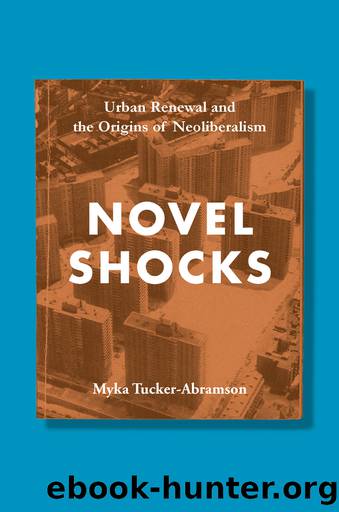Novel Shocks by Tucker-Abramson Myka;

Author:Tucker-Abramson, Myka; [Tucker-Abramson, Myka]
Language: eng
Format: epub
Publisher: Fordham University Press
Published: 2018-08-15T00:00:00+00:00
CHAPTER 5
Fallen Corpses and Rising Cities: The Bell Jar and the Making of the New Woman
At the center of Sylvia Plathâs The Bell Jar are two transformations: New Yorkâs transformation from the nineteenth-century industrial city of slums, tenements, and factories to a shiny new metropolis, and the transformation of Esther, who begins the novel as an anxious, sick, and needy tenderfoot but ends the novel as a seemingly independent, liberated, and autonomous subject. Throughout this book, Iâve been arguing that the correlation between urban transformations and the transformation of the subject is not incidental. Rather, key processes of transformation playing out in urban and suburban space effectively helped to shape the emergence of a new kind of subjectivity. In this chapter, I argue that The Bell Jar offers one of the first fully developed critiques of the racial violence under pinning the formation of this new entrepreneurial subject. Moreover, I suggest that it confronts the limit of this model of entrepreneurial freedom on its own terms.
Published in 1963, The Bell Jar is set in 1952âa date the novel marks by two events that emblematize the overlapping and intersecting dynamics of Cold War history and the transformations taking place in New York City: the construction of the United Nations Building, which was completed by the end of that year, and the execution of Julius and Ethel Rosenberg on June 19, 1953. Esther arrives into this scene having won a fashion magazine contest that lands her a coveted internship at a womenâs magazine in New York âfor a month, expenses paid, and piles and piles of free bonuses, like ballet tickets and passes to fashion shows and hair stylings at a famous expensive salon and chances to meet successful people in the field of our desireâ (3). Through Estherâs wide-eyed arrival into Manhattan, Plath provides one of the first comprehensive literary representations of New York in the age of urban renewal. This was a New York composed of the âslick marble and plate-glass fronts along Madison avenueâ (2) that housed a booming, postindustrial creative economy marked by an endless parade of commodities and an all-encompassing phantasmagoria of mass cultural forms, from ladiesâ magazines and commercial radio to movie theaters.
These urban and geopolitical markers have historically been underplayed in The Bell Jar criticism, which has largely forefronted how the double bind of consumer mass-culture and patriarchal 1950s values traps and confines women. Within this frame, The Feminine Mystique (1963)âthat 1950s bible of suburban feminist liberationâis read as the novelâs paratext (Dowbnia; Leach), with Estherâs mental breakdown becoming both a symptom and a condemnation of frustrated female desire and ambition that reveals the fate of âtalented yet powerless womenâ (Wagner-Martin, 61), or the bodily effects of a âgender-segregated knowledge economyâ that doesnât support âEstherâs hope of becoming a writerâ (Jernigan, 4). Within such a reading, the novelâs endingâher escape from New York, her assertion of (a rather circumscribed) sexual agency, and her becoming the author of the memoir we now hold in our handsâserves
Download
This site does not store any files on its server. We only index and link to content provided by other sites. Please contact the content providers to delete copyright contents if any and email us, we'll remove relevant links or contents immediately.
| Anthropology | Archaeology |
| Philosophy | Politics & Government |
| Social Sciences | Sociology |
| Women's Studies |
Cecilia; Or, Memoirs of an Heiress — Volume 1 by Fanny Burney(32075)
Cecilia; Or, Memoirs of an Heiress — Volume 3 by Fanny Burney(31469)
Cecilia; Or, Memoirs of an Heiress — Volume 2 by Fanny Burney(31419)
The Great Music City by Andrea Baker(30797)
We're Going to Need More Wine by Gabrielle Union(18641)
All the Missing Girls by Megan Miranda(14788)
Pimp by Iceberg Slim(13798)
Bombshells: Glamour Girls of a Lifetime by Sullivan Steve(13698)
Fifty Shades Freed by E L James(12925)
Talking to Strangers by Malcolm Gladwell(12888)
Norse Mythology by Gaiman Neil(12861)
For the Love of Europe by Rick Steves(11558)
Crazy Rich Asians by Kevin Kwan(8898)
Mindhunter: Inside the FBI's Elite Serial Crime Unit by John E. Douglas & Mark Olshaker(8720)
The Lost Art of Listening by Michael P. Nichols(7170)
Enlightenment Now: The Case for Reason, Science, Humanism, and Progress by Steven Pinker(6879)
The Four Agreements by Don Miguel Ruiz(6326)
Bad Blood by John Carreyrou(6284)
Weapons of Math Destruction by Cathy O'Neil(5845)
